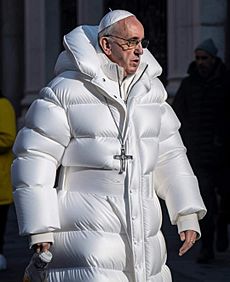Deepfake facts for kids
Deepfakes are fake videos or audio clips that look and sound very real. The word "deepfake" comes from "deep learning" (a type of artificial intelligence) and "fake." These fakes are made using powerful computer programs that can change someone's face or voice in a video or audio clip. It's like a super advanced way to trick people, making it hard to tell what's real and what's not.
Deepfakes have become well-known because they can be used to create fake news, hoaxes, or even for bullying. They can also spread wrong information, which might make it harder for people to know the truth. Because of this, many companies and governments are working to find ways to spot deepfakes and stop them from being used for bad things.
This technology is also used in fun ways, like in entertainment and video games. It's changing how movies, TV shows, and games are made, making them more exciting and realistic.
How to Spot Deepfakes
It can be tricky to tell if something is a deepfake because they are made to look very real. But experts are working on ways to find them.
Spotting Fake Audio
Finding fake audio is hard. Scientists use special computer programs that listen very closely to sound signals. They look for tiny clues that show the audio has been changed. Using deep learning helps these programs get better at telling real from fake.
Spotting Fake Videos
Most research on deepfakes focuses on videos. One way to spot them is by using computer programs that look for small mistakes or patterns that don't seem right. For example, some programs check if a person's eyes blink naturally or if the lighting on their face changes strangely.
However, this is like a "moving target." As people get better at spotting deepfakes, the people making deepfakes also get better at making them look real. To help with this, many big tech companies held a "Deepfake Detection Challenge." The best computer program in this challenge could spot deepfakes about 65% of the time. Interestingly, regular people were almost as good, spotting them about 69-72% of the time!
Some researchers found a clever way to spot deepfakes: they look at the reflections in a person's eyes. Since both eyes should have the same reflections from light sources, if they don't, it might be a deepfake. This method can be very successful.
For famous people like political leaders, special computer programs can learn their unique facial movements, gestures, and voice patterns. This helps them tell if someone is a deepfake trying to pretend to be that person.
One simple trick to check if a video call is a deepfake is to ask the person to turn their head sideways. This can sometimes break the illusion of the deepfake.
See also
 In Spanish: Deepfake para niños
In Spanish: Deepfake para niños


